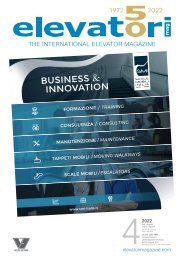Create successful ePaper yourself
Turn your PDF publications into a flip-book with our unique Google optimized e-Paper software.
Techniques<br />
Tecnica<br />
Call-giving devices in lift<br />
traffic design<br />
Dispositivi di chiamata nella<br />
progettazione del traffico<br />
Janne Sorsa 1 , Mikko Kontturi 2 & Mirko Ruokokoski 3<br />
1 - KONE Industrial Ltd, Keilasatama 3, FI-02150 Espoo, Finland/Finlandia<br />
2 - KONE Industrial Ltd, Hissikatu 3, FI-05830 Hyvinkää, Finland/Finlandia<br />
3 - KONE Corporation, Keilasatama 3, FI-02150 Espoo, Finland/Finlandia<br />
Part 2<br />
4. PASSENGER WALKING TIME IN LIFT<br />
TRAFFIC SIMULATION<br />
The impact of walking distances between<br />
call-giving devices and lifts on lift group<br />
performance and passenger service quality<br />
is studied by the same simulation setup<br />
as in the previous section.<br />
In all cases, interaction time T is kept at zero<br />
seconds and the number of call-giving devices<br />
at six.<br />
The walking distance is varied from 0<br />
to 60 meters in 5-meter steps, and it is translated<br />
to a walking time by assuming a constant<br />
walking speed of 1.0 m/s.<br />
Simulation results are shown in Table 4.<br />
Average number of passengers in the car<br />
at departure from the main entrance floor (P)<br />
and average roundtrip time (RTT) indicate<br />
that lift group handling capacity remains at 14%<br />
of population per five minutes up to a walking<br />
distance of 20 meters.<br />
Both measures are about the same for distances<br />
between 0 and 20 meters while, for the distances<br />
of 40 and 60 meters, they become clearly higher.<br />
Based on average roundtrip time with 14%<br />
passenger demand, a walking distance<br />
of 40 meters reduces handling capacity by 8.4%<br />
and 60 meters by 16.3%.<br />
The results indicate that the lift control system<br />
starts to lose its ability of allocating passengers<br />
going to the same destination to the same<br />
Parte 2<br />
4. DURATA DELLA DISTANZA PERCORSA<br />
A PIEDI DAI PASSEGGERI<br />
DURANTE LA SIMULAZIONE DEL TRAFFICO<br />
L’impatto delle distanze percorse a piedi<br />
tra i dispositivi di chiamata e gli ascensori<br />
sulle prestazioni del gruppo di ascensori e sulla<br />
qualità del servizio ai passeggeri viene studiato<br />
con le stesse impostazioni di simulazione rispetto<br />
alla sezione precedente. Ad ogni modo, il tempo<br />
di interazione T è mantenuto a zero secondi e il<br />
numero di dispositivi di chiamata a sei. La distanza a<br />
piedi è variata da 0 a 60 metri in intervalli di 5 metri,<br />
ed è tradotta in un tempo di cammino ipotizzando<br />
una velocità costante di 1,0 m/s. I risultati<br />
della simulazione sono illustrati nella Tabella 4.<br />
Il numero medio di passeggeri nella cabina<br />
alla partenza dal piano dell’ingresso principale<br />
(P) e il tempo medio di andata e ritorno (RTT)<br />
indicano che la gestione del traffico del gruppo<br />
di ascensori rimane al 14% della popolazione<br />
per cinque minuti fino a una distanza a piedi di 20<br />
metri. Entrambe le misure sono circa le stesse per<br />
le distanze tra 0 e 20 metri mentre, per le distanze<br />
di 40 e 60 metri, diventano chiaramente più alte.<br />
Sulla base del tempo medio di andata e ritorno con<br />
una domanda di passeggeri del 14%, una distanza<br />
a piedi di 40 metri riduce la gestione del traffico<br />
dell’8,4% e di 60 metri del 16,3%. I risultati<br />
indicano che il sistema di controllo dell’ascensore<br />
inizia a perdere la sua capacità di assegnare<br />
i passeggeri che vanno alla stessa destinazione<br />
allo stesso ascensore a causa dei vincoli del tempo<br />
48 ELEVATORIMAGAZINE.COM <strong>2021</strong> JULY | AUGUST • LUGLIO | AGOSTO <strong>2021</strong>














